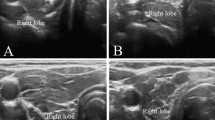Abstract
Purpose
The aim was to verify in a pediatric population with Hashimoto’s thyroiditis whether there is a relationship between antithyroid antibodies and inflammatory status on thyroid ultrasound and thyroid function.
Subjects and methods.
A total of 154 children and adolescents, aged 4 to 18 years, diagnosed with Hashimoto’s thyroiditis with normal body weight were followed up for 1 year.
Results
Patients with only antiperoxidase antibodies presented with higher TSH levels than subjects with only antithyroglobulin antibodies (p 0.027) but with similar FT4 levels and thyroid score. Prevalence of seronegative Hashimoto’s thyroiditis in this cohort was 12.3% (19/154). At diagnosis, the seronegative group presented with lower prevalence of overt hypothyroidism, symptoms of hypothyroidism, and thyroid score, meaning less severe thyroid involvement. In contrast, similar TSH and FT4 values were found at diagnosis and during follow-up in both the seronegative and seropositive groups. A comparison between patients with seronegative Hashimoto’s thyroiditis and an overweight/obese antibody-negative population, who presented superimposable altered parenchymal pattern on thyroid ultrasound without circulating antithyroid antibodies, presented similar clinical data.
Conclusion
We report for the first time in the literature that seronegative Hashimoto’s thyroiditis in the pediatric age group has a less severe pattern. The seronegative group presents similar characteristics to those of overweight/obese children and adolescents with ultrasound changes, but, according to the established knowledge, the latter condition is reversible and does not need follow-up examinations.
Similar content being viewed by others
Data availability
The data that support the findings of this study are not publicly available because they contain information that could compromise the privacy of research participants, but are available from the corresponding author upon reasonable request.
Abbreviations
- HT:
-
Hashimoto’s thyroiditis
- Abs:
-
Antibodies
- TGAbs:
-
Antithyroglobulin antibodies
- TPOAbs:
-
Antiperoxidase antibodies
References
Gutekunst R, Hafermann W, Mansky T, Scriba PC (1989) Ultrasonography related to clinical and laboratory findings in lymphocytic thyroiditis. Acta Endocrinol (Copenh) 121:129–135. https://doi.org/10.1530/acta.0.1210129
Rago T, Chiovato L, Grasso L, Pinchera A (2001) Vitti P (2001) Thyroid ultrasonography as a tool for detecting thyroid autoimmune diseases and predicting thyroid dysfunction in apparently healthy subjects. J Endocrinol Invest 24:763–769
Rotondi M, Coperchini F, Magri F, Chiovato L (2014) Serum-negative autoimmune thyroiditis: what’s in a name? J Endocrinol Invest 37:589–591. https://doi.org/10.1530/EJE-14-0147
Croce L, De Martinis L, Pinto S, Coperchini F, Dito G, Bendotti G et al (2020) Compared with classic Hashimoto’s thyroiditis, chronic autoimmune serum-negative thyroiditis requires a lower substitution dose of L-thyroxine to correct hypothyroidism. J Endocrinol Invest 43:1631–1636. https://doi.org/10.1007/s40618-020-01249-x
Radetti G, Kleon W, Buzi F, Crivellaro C, Pappalardo L, di Iorgi N et al (2008) Thyroid function and structure are affected in childhood obesity. J Clin Endocrinol Metab 93:4749–4754. https://doi.org/10.1210/jc.2008-0823
Cacciari E, Milani S, Balsamo A, Spada E, Bona G, Cavallo L et al (2006) Italian cross-sectional growth charts for height, weight and BMI (2 to 20 yr). J Endocrinol Invest 29:581–593. https://doi.org/10.1007/BF03344156
Tanner JM, Whitehouse RH (1976) Clinical longitudinal standards for height, weight, height velocity, weight velocity, and stages of puberty. Arch Dis Child 51:170–179. https://doi.org/10.1136/adc.51.3.170
Vitti P, Martino E, Aghini-Lombardi F, Rago T, Antonangeli L, Maccherini D et al (1994) Thyroid volume measurement by ultrasound in children as a tool for the assessment of mild iodine deficiency. J Clin Endocrinol Metab 79:600–603. https://doi.org/10.1210/jcem.79.2.8045982
Cesaretti G, Saggese G (2003) Accurate ultrasonographic evaluation in autoimmune juvenile thyroiditis with subclinical hypothyroidism: a useful tool to establish the treatment. A retrospective study. Horm Res 60(S2):107
Pedersen OM, Aardal NP, Larssen TB, Myking O, Vik-Mo H (2000) The value of ultrasonography in predicting autoimmune thyroid disease. Thyroid 10:251–259. https://doi.org/10.1089/thy.2000.10.251
Li Y, Teng D, Shan Z, Teng X, Guan H, Yu X et al (2008) Antithyroperoxidase and antithyroglobulin antibodies in a five-year follow-up survey of populations with different iodine intakes. J Clin Endocrinol Metab 93:1751–1757. https://doi.org/10.1210/jc.2007-2368
Yan YR, Gao XL, Zeng J, Liu Y, Lv QG, Jiang J et al (2015) The association between thyroid autoantibodies in serum and abnormal function and structure of the thyroid. J Int Med Res 43:412–423. https://doi.org/10.1177/0300060514562487
Licenziati MR, Valerio G, Vetrani I, De Maria G, Liotta F, Radetti G (2019) Altered Thyroid Function and Structure in Children and Adolescents Who Are Overweight and Obese: Reversal After Weight Loss. J Clin Endocrinol Metab 104:2757–2765. https://doi.org/10.1210/jc.2018-02399
Funding
This research was not supported by funding.
Author information
Authors and Affiliations
Contributions
CR and RF conceived, planned, and conceptualized the study. RF, VC, MB, AL, SL, and FL performed the study. MS and GR wrote the manuscript. All authors critically reviewed and edited the manuscript and approved the final version as submitted.
Corresponding author
Ethics declarations
Ethics approval
The latest revision of the Declaration of Helsinki and the Oviedo Convention were the basis for the ethical conduct of the study. The study protocol was designed and conducted to ensure adherence to the principles and procedures of good clinical practice and to comply with the Italian laws. Ethics approval was not required.
Consent to participate
Informed consent was obtained from all individuals included in this study.
Consent for publication
Not applicable.
Conflict of interest
The authors have no conflicts of interest to declare.
Additional information
Publisher's note
Springer Nature remains neutral with regard to jurisdictional claims in published maps and institutional affiliations.
Rights and permissions
About this article
Cite this article
Rizzardi, C., Franceschi, R., Cauvin, V. et al. Seronegative phenotype in a pediatric population with Hashimoto’s thyroiditis. Hormones 21, 271–276 (2022). https://doi.org/10.1007/s42000-022-00355-0
Received:
Accepted:
Published:
Issue Date:
DOI: https://doi.org/10.1007/s42000-022-00355-0




